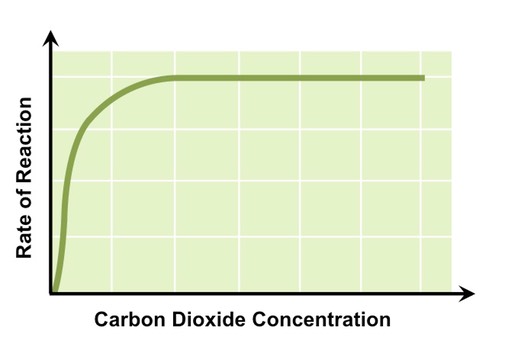![]()
Understanding:
• Temperature, light intensity and CO2 concentration are possible limiting factors on the rate of photosynthesis

The law of limiting factors states that when a chemical process depends on more than one essential condition being favourable, the rate of reaction will be limited by the factor that is nearest its minimum value
Photosynthesis is dependent on a number of favourable conditions, including:
- Temperature
- Light intensity
- Carbon dioxide concentration
Temperature
- Photosynthesis is controlled by enzymes, which are sensitive to temperature fluctuations
- As temperature increases reaction rate will increase, as reactants have greater kinetic energy and more collisions result
- Above a certain temperature the rate of photosynthesis will decrease as essential enzymes begin to denature
The Effect of Temperature on Photosynthetic Rate

Light Intensity
- Light is absorbed by chlorophyll, which convert the radiant energy into chemical energy (ATP)
- As light intensity increases reaction rate will increase, as more chlorophyll are being photo-activated
- At a certain light intensity photosynthetic rate will plateau, as all available chlorophyll are saturated with light
- Different wavelengths of light will have different effects on the rate of photosynthesis (e.g. green light is reflected)
The Effect of Light Intensity on Photosynthetic Rate

Carbon Dioxide Concentration
- Carbon dioxide is involved in the fixation of carbon atoms to form organic molecules
- As carbon dioxide concentration increases reaction rate will increase, as more organic molecules are being produced
- At a certain concentration of CO2 photosynthetic rate will plateau, as the enzymes responsible for carbon fixation are saturated
Effect of Carbon Dioxide Concentration on Photosynthetic Rate

![]()
Skill:
• Design of experiments to investigate the effects of limiting factors on photosynthesis
Photosynthesis can be measured directly via the uptake of CO2 or production of O2, or indirectly via a change in biomass
- It is important to recognise that these levels may be influenced by the relative amount of cell respiration occurring in the tissue
Measuring CO2 Uptake
- Carbon dioxide uptake can be measured by placing leaf tissue in an enclosed space with water
- Water free of dissolved carbon dioxide can initially be produced by boiling and cooling water
- Carbon dioxide interacts with the water molecules, producing bicarbonate and hydrogen ions, which changes the pH (↑ acidity)
- Increased uptake of CO2 by the plant will lower the concentration in solution and increase the alkalinity (measure with probe)
- Alternatively, carbon dioxide levels may be monitored via a data logger
Measuring O2 Production
- Oxygen production can be measured by submerging a plant in an enclosed water-filled space attached to a sealed gas syringe
- Any oxygen gas produced will bubble out of solution and can be measured by a change in meniscus level on the syringe
- Alternatively, oxygen production could be measured by the time taken for submerged leaf discs to surface
- Oxygen levels can also be measured with a data logger if the appropriate probe is available
Measuring Biomass (Indirect)
- Glucose production can be indirectly measured by a change in the plant’s biomass (weight)
- This requires the plant tissue to be completely dehydrated prior to weighing to ensure the change in biomass represents organic matter and not water content
- An alternative method for measuring glucose production is to determine the change in starch levels (glucose is stored as starch)
- Starch can be identified via iodine staining (turns starch solution purple) and quantitated using a colorimeter
